Cats are creatures of curiosity, especially when it comes to plants and gardens. They hide in all of those tight ‘cat sized’ spaces and do their business, munching on whatever they feel like without any consequence.
Curiosity is a great attribute, except when toxic plants are involved. Cats simply can’t tell the difference, and it’s hard to tell them that.
So, are wandering jew plants toxic to cats?
Honestly, the wandering jew plants are a bit toxic to cats, but the toxicity isn’t going to take the lives of the cats. These plants contain calcium oxalate crystals which can form unwanted small stones inside the bladder and urinary tract of the cats.
It’s also hard to mention that when consumed in abundance, toxic plants can lead to organ failure using poisoning. Depending on the amount consumed, they can die from their organs shutting down. In minor cases, it can also be treatable.
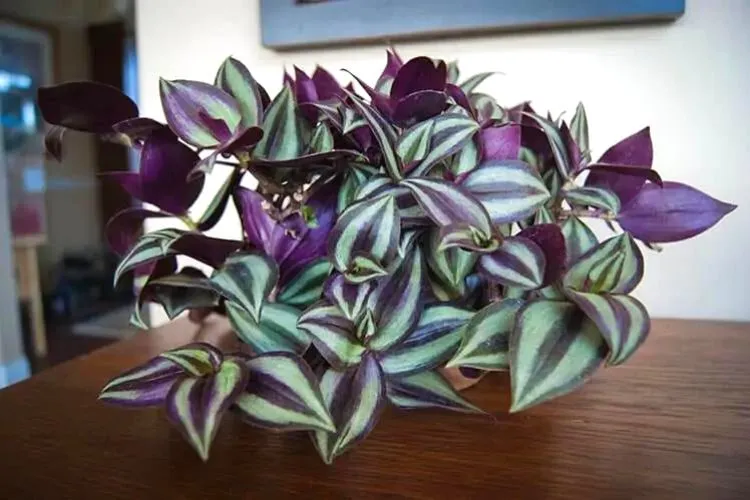
We firmly believe that the best solution is to mitigate rather than react.
In this article, we’ll go deeper into the topic, specifically mentioning the wandering jew plant. Furthermore, we’ll look into ways to prevent cats from becoming sick from these plants.
Table of Contents
Are wandering jew plants toxic to cats? (The Truth)
According to ASPCA (American Society for the Prevention of Cruelty to Animals), the Wandering Jew Plant (Tradescantia. Zebrina) is toxic to cats but not enough to kill them.
These peculiar looking trailing tropical plants are considered both harmless and toxic when consumed by cats. Here’s why: They contain calcium oxalate crystals within their leaves and stems.
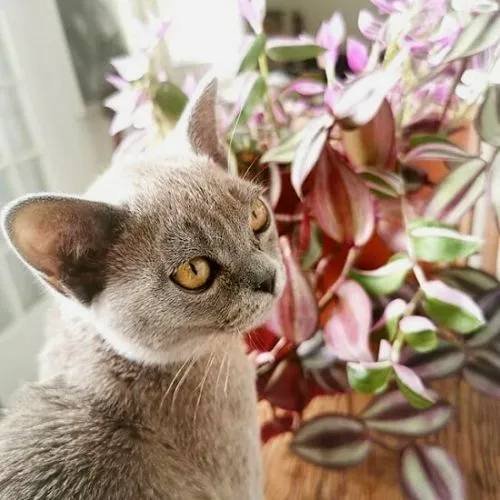
If high amounts of these calcium oxalate crystals are consumed, they can form small stones inside the bladder and urinary tract of cats, dogs, and horses.
Luckily, the amount these plants contain isn’t enough to kill a cat, although they can suffer from serious discomfort. They may also need to visit the vet if the stones build up and cannot be passed naturally.
Most toxic plants will start affecting smaller house animals, such as cats, within 2-3 hours from consumption. The symptoms to look out for include vomiting, diarrhea, salivation, lack of appetite, and/or depression. The sooner an illness caused by toxic plants is discovered, the better the chance the animal has to recover or even survive.
If you notice that your cat is showing any of the mentioned symptoms and you’re sure that you have toxic plants that may have been consumed, the best course of action is to do as follows:
- Move your cat to somewhere safe and out of any harm (Onto a blanket or tucked away in a cat carrier)
- Contact an animal poisons specialist (usually a veterinarian) and organize to get the cat in to see them ASAP. Additionally, try to ascertain whether or not the plant was one that is considered toxic.
- Calmly and gently remove any plant remains (if any) from the cat’s mouth, paws and fur. (Put them, if any, in a zip lock bag or something similar to present to the vet as a sample)
- If necessary, give the cat a gentle wash on the affected areas with some warm water and a non -irritating soap.
- Bring some of the plants as a sample for the vet.
How do I keep my cat from eating a poisonous plant?
If you have a curious cat and a toxic plant or two growing around the house, it’s probably a good idea to mitigate the cat’s curiosity.
It’s only a matter of time before they get through chewing everything you have and end up with the wrong type of plant in their mouth. Luckily, there is a simple solution that doesn’t have to cost the earth and is also environmentally friendly.
Cats hate the taste and smell of any citrus fruit. Simply mixing fresh lemon, lime, or orange juice with water in a spray bottle will soon become your favorite pastime.
To save your cat, of course, this blend can be sprayed directly on the plant’s leaves to ward off your feline buddy. If you don’t want to spray, you can leave either one of the citrus peels in the plant’s soil. The stench will protect the plant and the cat for as long as the peel stays fresh.
What are the most toxic houseplants for cats?
When it comes to cats and plants, it’s a bit hit and miss. The biggest issue surrounding the connection between the two is the danger some can cause through toxicity.
Cats are curious by nature; it’s up to us as humans to keep them safe. In saying that, here’s a list of some of the most common toxic plants found in the home that are harmful to our feline friends.
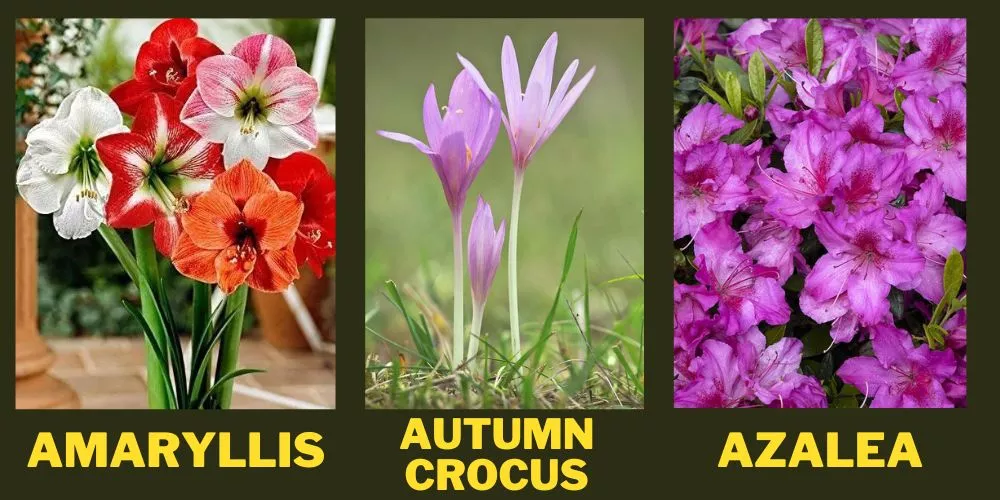
Amaryllis
These festive plants contain the toxin alkaloid lycorine. When ingested by humans and pets, it can cause vomiting, depression, diarrhea, abdominal pain, hypersalivation, and tremors.
Autumn crocus
This beautiful light purple bulbar contains colchicine and its derivatives and is highly toxic. When ingested by pets, the symptoms can include severe vomiting, gastrointestinal bleeding, liver and kidney damage, and respiratory failure. If you have these plants and notice your pet acting this way, take it straight to a vet.
Azalea/rhododendron
Certain species of the rhododendron family have toxic amounts of grayanotoxins. When the leaves, nectar, or flowers are ingested, there can be serious consequences. You may notice excessive drooling, loss of appetite, digestive upset that includes colic and diarrhea, weakness, and loss of coordination.
Furthermore, an increased heart rate and leg paralysis can occur. Cats can suffer from cardiovascular complications and die within days if this condition isn’t corrected as soon as possible.
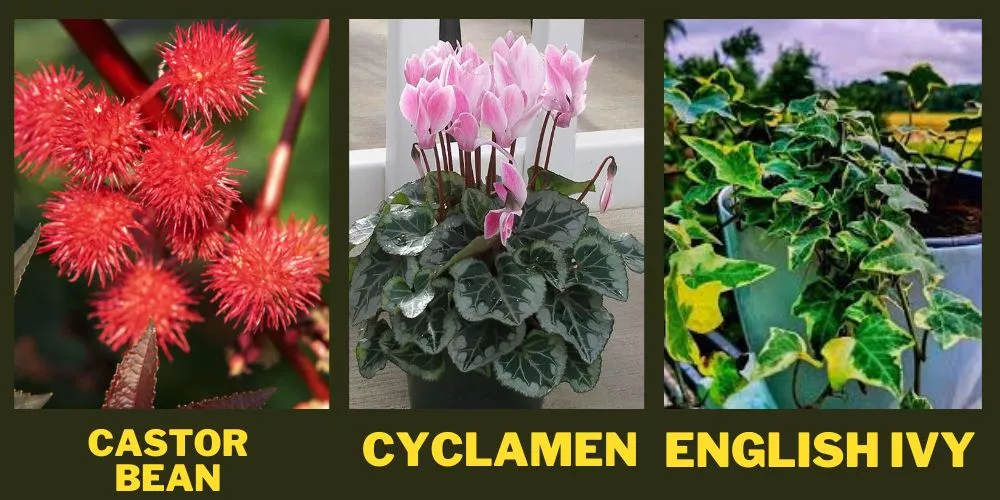
Castor bean
Caster beans contain the toxin protein Ricin,’ which is extremely dangerous. Initially, it can cause abdominal pain, drooling, vomiting, diarrhea, excessive thirst, weakness, and loss of appetite.
If left unattended or a lot has been ingested, it can make a cat have muscle cramps, tremors, and seizures and ultimately put them in a coma where it will eventually die.
Chrysanthemum
The flower heads of this plant contain toxic amounts of pyrethrum when ingested by all life forms. Symptoms of poisoning by a Chrysanthemum include gastrointestinal issues, drooling, vomiting, and diarrhea. In some cases, you may notice depression and loss of coordination.
Cyclamen
Cyclamen contain irritating saponins, which are dangerous when ingested from mostly the tubers and roots. Eating these plants can cause significant gastrointestinal irritation, which produces drooling, intense vomiting, and/or diarrhea.
The toxicity levels of this plant aren’t as high as many others, but the more of the plant consumed, the greater the effect of the poison.
English ivy
This common vining ivy contains high amounts of triterpenoid saponins. If any pet, let alone a cat, eats these, they may suffer extreme discomfort. The ingestion symptoms include vomiting, abdominal pain, hypersalivation, and diarrhea.
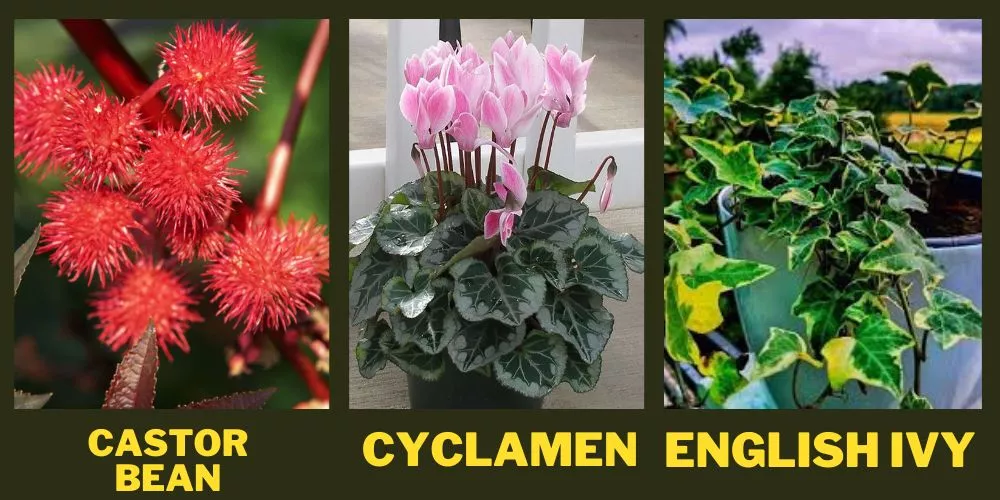
Kalanchoe
Kalanchoe contains cardiac glycosides found in the wild and can affect cats and other farm animals. These toxins generally cause heart issues but are also known to induce gastrointestinal irritation.
Symptoms include vomiting and/or diarrhea. Cats don’t like the taste and usually stop eating it before becoming sick.
Lilies
Lillies are highly toxic to cats; even the tiniest lick of leaf, flower petal, or pollen grains, as well as vase water, can be lethal. Thai include grooming themselves with small traces of the plant on them. The toxins found in all components of lilies can cause kidney failure
Marijuana
The levels of sativa in Marijuana are toxic to cats but rarely fatal. The symptoms of marijuana poisoning include incoordination, vomiting, diarrhea, drooling, increased heart rate, and possible seizures.
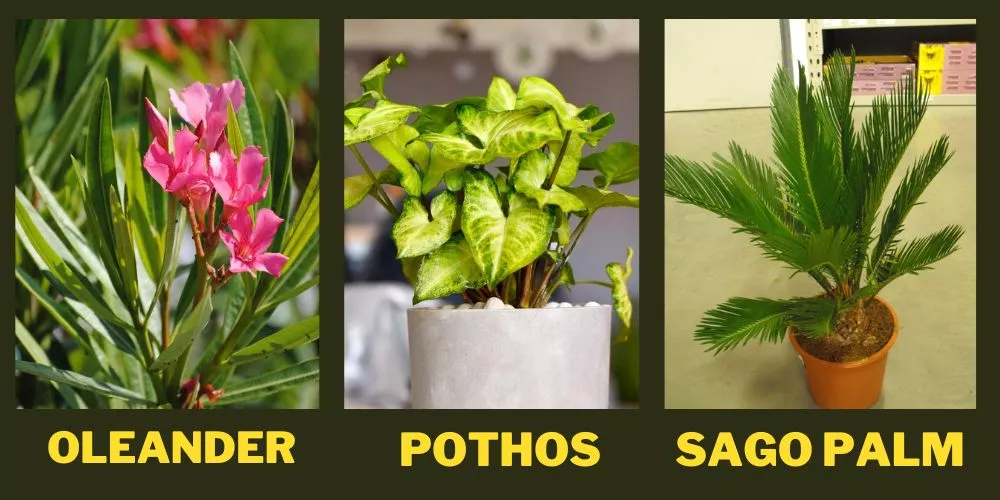
Oleander
Oleander is considered highly toxic to cats. It contains cardiac glycosides, which can bring on serious effects if ingested. These may include gastrointestinal tract irritation, abnormal heart function, hypothermia, and even death. Even smaller amounts can be fatal.
Peace lily (aka Mauna Loa Peace lily)
The humble Peace Lily is filled with high amounts of calcium oxalate crystals. These can cause cat issues, including oral irritation (mouth, lips, and tongue. If ingested, the cat will show visible signs such as excessive drooling, vomiting, and difficulty swallowing.
Pothos
Pothos contain calcium oxalate, which causes mouth burning and skin irritation when consumed by cats. Additionally, they may suffer from gastrointestinal tract issues. Generally, poisoning from Pothos isn’t fatal but can cause extreme discomfort.
Sago palm
The Sago palm can cause nasty issues for a curious cat because the whole plant has poisonous sections. The seeds have the highest concentration, though.
They contain several toxins, including cycasin, Beta Methylamino L-alanine, and a neurotoxic amino acid. If even just a small amount of this plant is consumed, a cat will suffer from vomiting, diarrhea, depression, seizures, and liver failure.
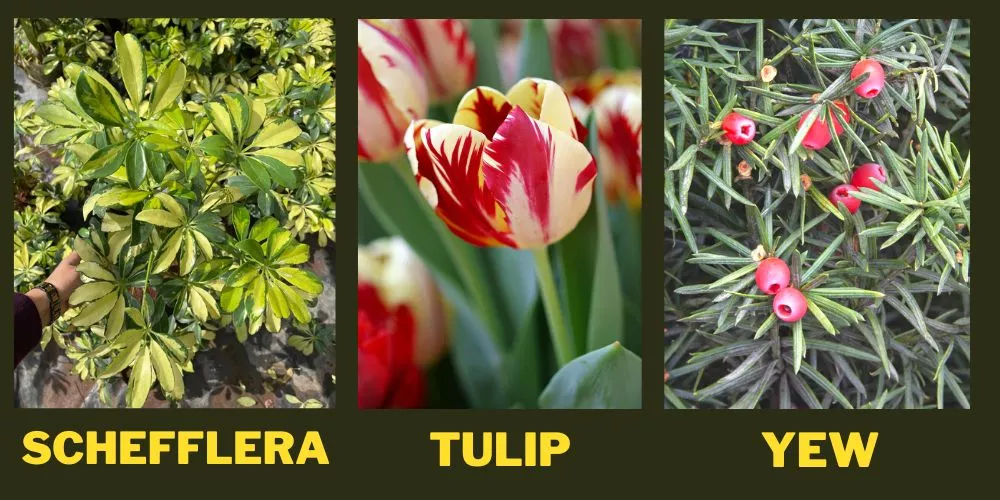
Schefflera
Schefflera is another one of the many plants that contain calcium oxalate crystals. These toxic spores are known to cause a range of issues that are headed by oral irritation.
The symptoms may include excessive drooling, vomiting, difficulty swallowing, and intense burning and irritation of the mouth, lips, and tongue. These symptoms are visually noticeable, especially with cats.
Tulip/narcissus bulbs
The bulb portions of tulips contain alkaloid and glycoside compounds. These toxins rarely cause convulsions and death. However, the symptoms of Tulip poisoning can cause many discomfort to cats.
These include gastrointestinal irritation from dizziness, nausea, and general abdominal pain. In some cases, the toxins can trigger cardiac abnormalities.
Yew
The Yew plant is another nasty one and can cause death to cats. It contains taxine, weakens the central nervous system become weak, and brings on trembling, incoordination, and difficulty breathing.
If enough of the plant is ingested, the cat can suffer from significant gastrointestinal irritation and major heart problems, resulting in death.
Frequently Asked Questions (FAQs)
Which plants are most toxic to cats?
Many toxic plants can cause major health issues for cats. Some of the more common species include Oleander, Peace Lily, Pothos (Devil’s Ivy), Sago Palm, Spanish Thyme, Tulip, and Yew, to name a few.
Will cats eat poisonous plants?
Cats are curious by nature and will munch on just about anything to test the taste. They can’t tell which plants they shouldn’t eat before doing so. You can mitigate the risk of them eating a toxic plant by spraying any citrus juice onto the leaves or leaving some citrus peels around the base. Cats hate the stench of all citrus fruits.
How long does it take for a toxic plant to affect a cat?
It all depends on how toxic a plant is, what type of toxins they contain and how much is induced. In the worst case, you should expect as little as 0-30 minutes to see some kind of visual sign that a cat has been poisoned.
What can I spray on plants to keep cats away?
Using the juice of any citrus fruit (lemon, orange, lime) diluted in water and adding it to a spray bottle is the perfect natural deterrent for curious cats. Simply spray on the leaves of the toxic plant. Cats dislike citrus; they will steer well clear of these scents. Even adding some citrus peels to the use of a toxic plant is effective.
Is wandering zebrina toxic to cats?
The Wandering Jew Plant (Zebrina) is toxic to cats but not enough to cause serious harm. It is considered mildly toxic, so if enough is ingested, it can cause minor health complications. These include irritation to the skin and bowel.
Conclusion:
Even if a plant is known to be slightly toxic, it’s not worth taking the risk around cats. Our feline friends are curious by nature and will always want to ‘push the red button when the chance arrives.
Knowing which plants are possibly poisonous is hands down, the best way to mitigate any potential issues. We hope this article has been helpful, and we look forward to seeing you next. As always, happy growing!


